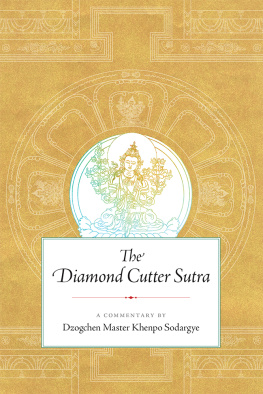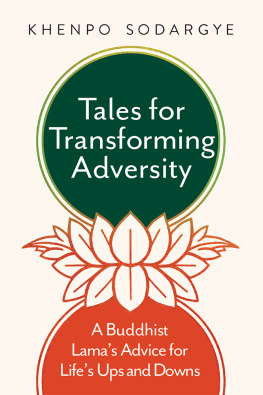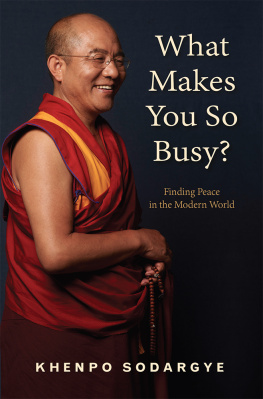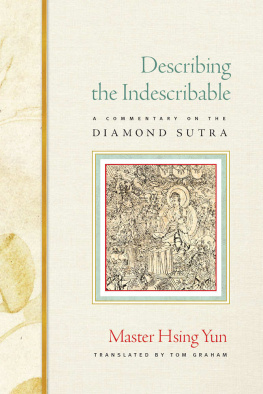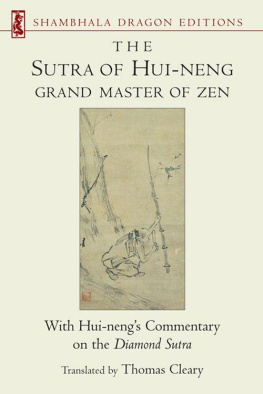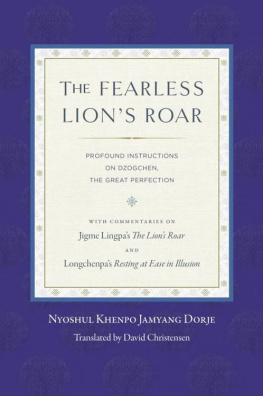Khenpo Sodargye - The Diamond Cutter Sutra
Here you can read online Khenpo Sodargye - The Diamond Cutter Sutra full text of the book (entire story) in english for free. Download pdf and epub, get meaning, cover and reviews about this ebook. publisher: Wisdom Publications, genre: Religion. Description of the work, (preface) as well as reviews are available. Best literature library LitArk.com created for fans of good reading and offers a wide selection of genres:
Romance novel
Science fiction
Adventure
Detective
Science
History
Home and family
Prose
Art
Politics
Computer
Non-fiction
Religion
Business
Children
Humor
Choose a favorite category and find really read worthwhile books. Enjoy immersion in the world of imagination, feel the emotions of the characters or learn something new for yourself, make an fascinating discovery.
- Book:The Diamond Cutter Sutra
- Author:
- Publisher:Wisdom Publications
- Genre:
- Rating:3 / 5
- Favourites:Add to favourites
- Your mark:
- 60
- 1
- 2
- 3
- 4
- 5
The Diamond Cutter Sutra: summary, description and annotation
We offer to read an annotation, description, summary or preface (depends on what the author of the book "The Diamond Cutter Sutra" wrote himself). If you haven't found the necessary information about the book — write in the comments, we will try to find it.
The Diamond Cutter Sutra — read online for free the complete book (whole text) full work
Below is the text of the book, divided by pages. System saving the place of the last page read, allows you to conveniently read the book "The Diamond Cutter Sutra" online for free, without having to search again every time where you left off. Put a bookmark, and you can go to the page where you finished reading at any time.
Font size:
Interval:
Bookmark:

K HENPO SODARGYE was born in Tibet in 1962 in what is today the Sichuan Province of China. He spent his early years herding yaks, and after attending Garze Normal School entered Larung Gar Buddhist Institute in Sertar, becoming a monk in 1985 under the great Jigme Phuntsok Rinpoche. Khenpo served Rinpoche as his personal and teaching interpreter on overseas tours in Asia, Europe, and North America as well as at Larung Gar. Khenpo has taught and translated the Dharma for over thirty years and has lectured on Buddhism and social issues in over a hundred universities around the world. He is one of the leading scholars at Larung Gar and has popularized Tibetan Buddhism among Han Chinese students with numerous bestselling books.

The publisher gratefully acknowledges the generous help of the Hershey Family Foundation in sponsoring the production of this book.

I N THE PROFOUND TEACHINGS of the Diamond Cutter Sutra, the Buddha offers a view of the world that deconstructs our normal categories of experience to show us that what we think are real entities in the world are actually our conceptualizations. The Buddha teaches us to cut our attachment to all phenomena and to the I, which are empty of inherent existence, and in so doing, cut the root cause of our suffering. Yet without wise guidance we may think that because all phenomena are empty there is no need to be attached to virtue, and thus we fall into the worst trap of allan attachment to emptiness. How do we destroy our attachment without being led astray?
With this question in mind, Dzogchen Master Khenpo Sodargye provides sparkling commentary on the Diamond Cutter Sutra so that we understand its actual meaning, thus preparing us to understand the view of the Great Perfection and Mahamudra. Before recognizing the nature of the mind, we learn we must hold on to things that are virtuous and right. Like a boat, these can help us cross a river; until we reach the other shore, it makes no sense to give them up.

Join Wisdoms mailing list and find out what to read next!
Receive the latest news and updates from Wisdom, including new releases and special offers.
Click here to sign up.


Thus have I heard, once the Bhagavan was dwelling in Shravasti, at the Jeta grove of the Anatapindada garden, together with a great sangha of 1,250 monks.
O NCE WHEN Buddha Shakyamuni was living with a sangha of 1,250 fully ordained monks at Jetavana Anatapindada garden in Shravasti, I heard the Buddha say thus. According to Mahayana, this passage explains the five perfections:
The perfect place: Jetavana Anatapindada garden in Shravasti.
The perfect time: sometime after Buddha Shakyamuni reached buddhahood.
The perfect followers: 1,250 fully ordained monks.
The perfect teaching: the profound meaning explained in the Diamond Cutter Sutra.
The perfect teacher: the guide of the three realms, Buddha Shakyamuni.
These words, added by sutra compilers, mean, I heard these vajra words at that time. What did they hear? The Diamond Cutter Sutra that is about to be explained.
Before entering the great parinirvana, Buddha Shakyamuni gave permission to Ananda and other disciples to compile the three baskets (Tripitaka) of teachings: the Sutra, Vinaya, and Shastra. In order to demonstrate the authority of a sutra, they should add (1) at the beginning, Thus have I heard, once; (2) connections in the middle, like the Bhagavan asked and Manjushri answered; and (3) at the end praise, like gods, nagas, humans, asuras, and gandhavas all rejoiced.
Furthermore, sutras fall into three categories: taught by the Buddha in person, taught through the blessings of the Buddha, and taught with the permission of the Buddha. Thus have I heard was not said by the Buddha in person but it was added with permission of the Buddha.
After the Buddha entered parinirvana, three councils were convened to compile the Buddhas doctrines. There is disagreement on when these councils were held. Some say they occurred two years after the Buddhas parinirvana, others say 110 years, or 180 years, or close to 400 years after. It is impossible to be certain. What is known is that through these three compilations, the Tripitaka was written down.
In regard to the compilation of the Tripitaka, it is generally agreed that the Sutra Pitaka, or Basket of Discourses, was compiled by Ananda, who was the foremost disciple in scholarship and memory; the Vinaya Pitaka by Upali, who was the foremost disciple in upholding pure precepts; and the Abhidharma Pitaka by Mahakasyapa, the disciple who was unexcelled in ascetic practices.
Since the Diamond Cutter Sutra belongs to the Sutra Pitaka, I in Thus have I heard refers to Venerable Ananda.
Once could be explained in two ways:
1. When the Buddha gave a teaching. There have been debates on how long the Buddha taught the Dharma. Some believe for forty-nine years, while others say for only forty-five years. Since it was not clearly recorded in which year and on which day this Diamond Cutter Sutra was taught, here once could be explained as one day.
2. When an ordinary being gives a Dharma teaching, it must have a specific time, place, audience, and subject, but for the Buddha, these are not necessarily fixed. The Buddha could give various teachings to different sentient beings in countless worlds in the past, in the present, and in the future simultaneously. This state is inconceivable and unfathomable. In this way, once could also include the three times of past, present, and future.
According to the Commentary on the Ornament of Clear Realization, just like Vaishali and Sarnath, Shravasti was one of the six great cities of ancient India and was ruled by King Prasenajit at the time of the Buddha.
There is a story about this garden: After taking refuge in the Buddha, the lay practitioner Anatapindada requested the Buddha to give teachings in Shravasti and planned to buy land to build a monastery there for the Buddha. He searched and found that the garden of Prince Jeta was pleasant, peaceful, and suitable for meditation. So he explained to the prince his intention to buy this land.
Reluctant to sell this garden, the prince joked with him, Unless you can cover the whole land with gold, I will not sell it. Since he had made offerings to six buddhas in his past lives, Anatapindada had the supreme merit of being able to see treasures buried underground. So he went home, opened his treasure house, and with the help of his elephants, transported enough gold to cover the land.
Inspired by his earnestness, Prince Jeta said, When we discussed this transaction, we didnt include the trees. The land is now yours, but the trees are still mine. Lets offer this garden to the Buddha together.
Font size:
Interval:
Bookmark:
Similar books «The Diamond Cutter Sutra»
Look at similar books to The Diamond Cutter Sutra. We have selected literature similar in name and meaning in the hope of providing readers with more options to find new, interesting, not yet read works.
Discussion, reviews of the book The Diamond Cutter Sutra and just readers' own opinions. Leave your comments, write what you think about the work, its meaning or the main characters. Specify what exactly you liked and what you didn't like, and why you think so.

